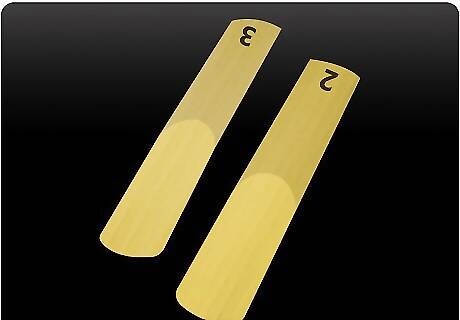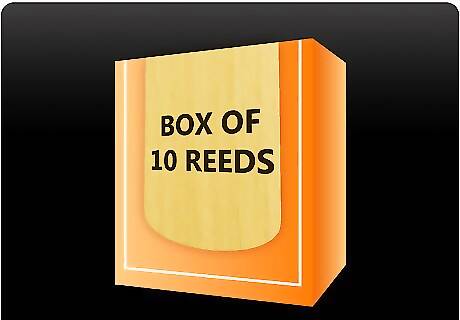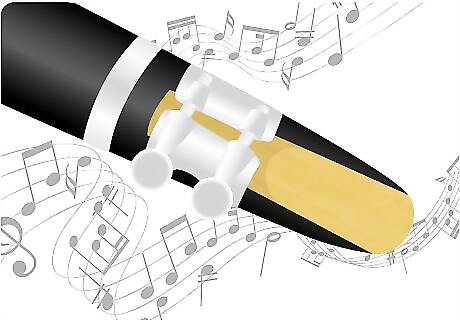
views

Choose a brand. There are many to choose from, and all brands make and sell their reeds a little differently. Rico, a US brand, is popular with all clarinetists, and is often recommended for beginners. It also makes reeds under the La Voz and Mitchell Lurie names. Vandoren (which also makes mouthpieces) is a popular French brand. Other French brands, some lesser known than others, include Selmer (which also makes clarinets), Rigotti, Marca, Glotin, and Brancher. Some other (and more uncommon) brand names are Alexander Superial (Japan), Reeds Australia, Peter Ponzol (also makes mouthpieces), RKM, and Zonda. If you're still relatively new to playing, Rico and Vandoren are both highly recommended brands.

Decide what strength you'll need. Most reed manufacturers sell reeds in strengths from 1 to 5, often in half-steps. A 1 would be the softest, and a 5 would be the hardest. Some brands use "soft", "medium", and "hard" instead. For a beginner, a 2, or 2 /12 would be the best starting point. Keep in mind, however, that what one brand calls a 2 1/2 may be another brand's 2 or 3. Also, a box of 2 1/2s will have some variants... some that are closer to a hard 2, or a soft 3. A harder reed gives a heavier, thicker, and fuller sound. It's more difficult to correct the pitch with a harder reed, but it also means that changing dynamics won't result in pitch variations as easily. It's also more difficult to play low pitches softly with a hard reed, but altissimo notes are easier to reach. A softer reed makes playing easier - the reed speaks more easily, and gives a lighter, brighter sound. However, there is a greater chance for pitch variations as you play, though it is easier to correct the pitch with your embouchure. High notes can be difficult to achieve with a soft reed. Also, fast tonguing (16th notes at 90 or more BPM) can be harder on softer reeds.

Decide on a cut. Reeds come in either "regular" or "French file" cuts. Cut won't matter to a beginning student, but file-cut reeds generally have a faster response time, and the few extra bucks to buy them are definitely worth it. You can identify a regular-cut reed as having the cane on the bottom meet the sanded part in a clean U-shape. On a file-cut reed, part of the "U" has been shaved down a bit to create a flat edge on the thick cane (see image). Players with darker-sounding mouthpieces may prefer filed reeds, while ones with brighter-sounding ones will stick with regular-cut ones.

Go to the music store and buy a box of reeds. It's okay to buy one or two, but the more reeds you have, the more good ones you have, and buying in bulk will save you a lot of trips to the music store. A box of ten should last you a few weeks, though you can choose to buy more.

Take all the reeds out of the box, and get ready to evaluate them. Check for splits and cracks. Throw away any broken reeds - they're beyond hope already.Choose a Reed for a Clarinet Step 5Bullet1.jpg Hold them up to the light, one at a time. You should see an inverted "V" shape. A good reed has a perfectly centered and symmetrical "V". A "crooked" V will be hard to play, and there is a risk of squeaks. However, if the "V" is only slightly off-centered, you can remedy the problem by shifting the reed slightly so that the "V" is centered on the mouthpiece (not centered on the reed) An uneven grain (where the little vertical lines in the reed are pointing towards the V instead of running straight through it) will not play well, either. A reed with knots (little spots or dark areas in the grain) will vibrate unevenly, and is also a dud. Take a look at the color. A good reed is yellow to golden-brown. A green reed is too young, and will not play well, if it plays at all. Take green reeds and leave them somewhere for a few months - sometimes they improve themselves over time.Choose a Reed for a Clarinet Step 5Bullet5.jpg

Play-test the good reeds. The duds can be thrown away or left to sit for a few months, depending on what was wrong, and you should be left with a handful of good ones. Test them to make sure they play well, and always have at least 3 good reeds on hand. You can purchase a special reed holder for this.




















Comments
0 comment